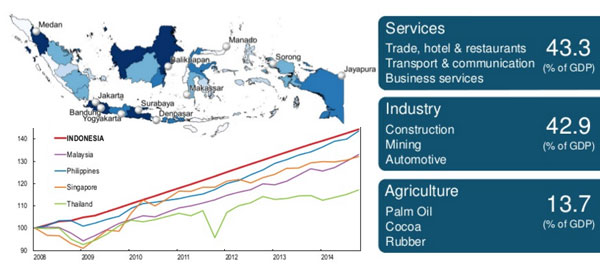Indonesia has been one of the fastest growing economies of Southeast Asia for several years, and so it remains in 2015. Other positive results in poverty reduction, governance and abundant natural resources compensate certain negative aspects in Indonesia and challenges to apprehend in several key sectors.
Introduction to Indonesia’s economy
At a turning point of its internal politics and foreign diplomacy, the Indonesian economy has shown some resilience in uneasy times. This first slide decks presents a general overview of the economy of Indonesia: key strengths and challenges, investment, trade and key partners.
Indonesia at a crossroad – summary
- Overview of ASEAN markets – slide 2
- Foreign Direct Investments in Indonesia by regions – slide 3
- Indonesia: the heavyweight of ASEAN – slide 4
- A large population with growing revenues – slide 5
- A major challenge: infrastructure – slide 6
- An economy fueled by services – slide 8
- Regional and global economic agreements – slide 9
- Imports and exports – slide 10
- Competition for FDI in Southeast Asia – slide 11
- Investors bullish on Indonesia – slide 12
- Investments structure – slide 13
- Investing nations – slide 14
- Policies to attract investments… – slide 15
- … and expanding tax base – slide 16
- Near-term challenges – slide 17
- Business regulation reforms – slide 18
- Challenges to investments – slide 19
- President Joko Widodo’s policies – slide 21
Insights on Indonesia’s strength and challenges
With more details on the key challenges and strengths of the economy, this second slide deck by OECD present macroeconomic data and recommendations. Targeted for public policy makers, it can also benefit larger companies to help them integrate key aspects in their broader strategies and developments efforts.
OECD Economic survey of Indonesia 2015 – summary
Key advantages of Indonesia
- Indonesia has enjoyed a strong and stable growth – slide 2
- Poverty has declined markedly – slide 3
- Its population is youthful – slide 4
- Main findings – slide 5
- Key recommendations – slide 6
Challenges ahead – slide 7
- The fiscal positioning is strong – slide 8
- The government is relatively small – slide 9
- Tax revenues are low – slide 10
- The external balance has deteriorated – slide 11
- Progress in tackling corruption and improving governance need to continue – slide 12
Policies to make growth more inclusive and sustainable – slide 13
- More structural change is needed – slide 14
- Improving infrastructure is a top priority – slide 15
- Education spending should be stepped up – slide 16
- Improve the performance of the education system – slide 17
- Labour market informality is too high – slide 18
- The targeting of social security programmes should be tightened – slide 19
- Measures to improve the performance of the social security system – slide 20
Making the most of natural resources – slide 21
- Productivity growth in agriculture has been uneven – slide 22
- The energy mix is tilted towards fossil fuels – slide 23
- Illegal logging, agriculture and mining are contributing to deforestation – slide 24
- Measures to make the most of natural resources – slide 25
Interactive graphics, as well as the full report in English and Bahasa Indonesia can be found on the OECD’s website.
Presentations from November 2015 by Tractus Asia Lts. and from March 2015 by Wendy Stokle of OECD


![FinTech startups in Indonesia [list] Indonesia FinTech startups](https://aseanup.com/wp-content/uploads/2016/10/Indonesia-FinTech-startups-150x68.jpg)






